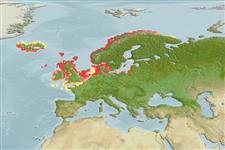Common names from other countries
Classification / Names / Names
Nomes comuns | Sinônimos | Catalog of Fishes (gen., sp.) | ITIS | CoL | WoRMS
Environment: milieu / climate zone / depth range / distribution range
Ecologia
; intervalo de profundidade 20 - 40 m (Ref. 19). Temperate
Northeast Atlantic.
Length at first maturity / Tamanho / Peso / Idade
Maturity: Lm ? range ? - ? cm Max length : 0.0 cm TL macho/indeterminado; (Ref. 1173)
Acoelomate, bilaterally symmetrical and with differentiated cuticle marine metazoan. Compound cilia for filter feeding working as a downstream-collecting system.
Inhabits the mouth appendages of Norway lobsters (Nephrops norvegicus) with carapace lengths of greater than 3.5 mm. Commensal with lobster. Feeding stages alternating with brief, non-feeding, free-swimming stages. Sessile, solitary feeding stages with multiciliated cells in the gut, anus just behind a ciliated mouth ring, and internal budding with extensive regeneration of feeding apparatus (Ref. 376).
Life cycle and mating behavior
Maturidade | Reprodução | Desova | Ovos | Fecundidade | Larvas
Brooding of asexual larva (Pandora larva), male and female. Females brooding chordoid larva with a mesodermal, ventral rod of plate-like muscle cells (chordoid structure) and a pair of protonephridia with multiciliated terminal.
Obst, M. and P. Funch. 2005. (Ref. 376)
Status na Lista Vermelha da IUCN (Ref. 130435)
Status no CITES (Ref. 108899)
Not Evaluated
Not Evaluated
Perigo para os humanos
Harmless
Uso pelos humanos
| FIRMS (Stock assessments) | FishSource |
Ferramentas
Mais informação
Nomes comunsSinônimosPredadoresReproduçãoMaturidadeDesovaFecundidadeOvosDesenvolvimento dos ovos
Idade/TamanhoCrescimentoComprimento-pesoComprimento-comprimentoMorfologiaLarvasAbundância
Fontes da internet
Estimates based on models
Preferred temperature
(Ref.
115969): 5.4 - 10.7, mean 9.4 (based on 94 cells).
Vulnerabilidade
Moderate to high vulnerability (50 of 100).
Categoria de preço
Unknown.
